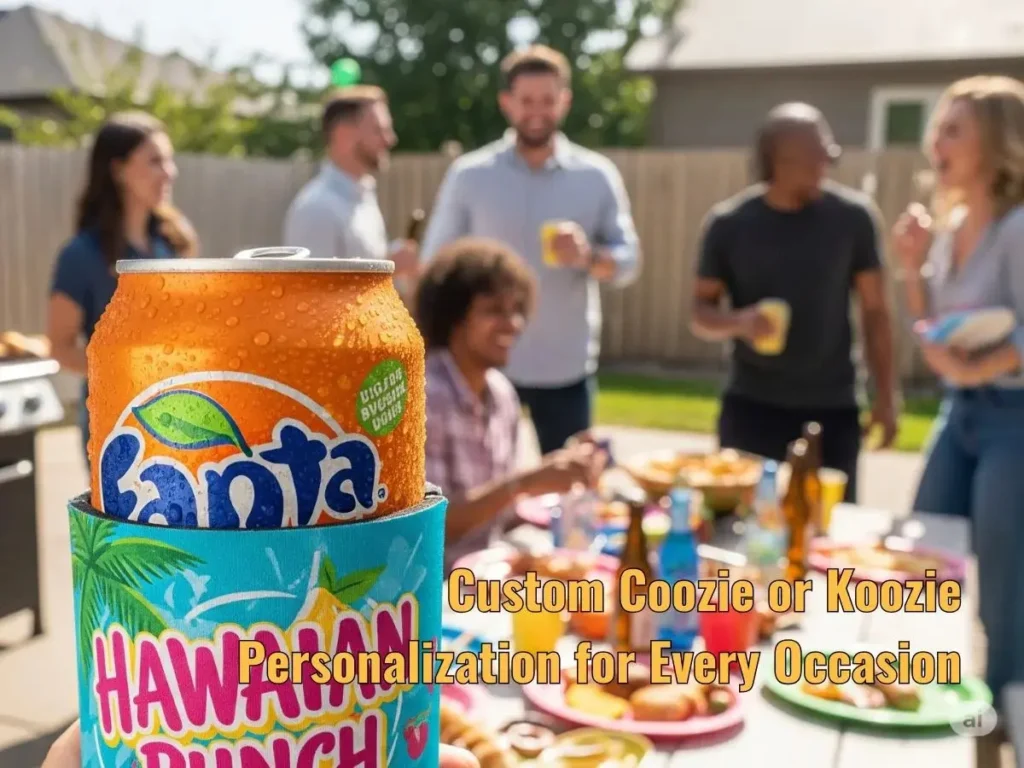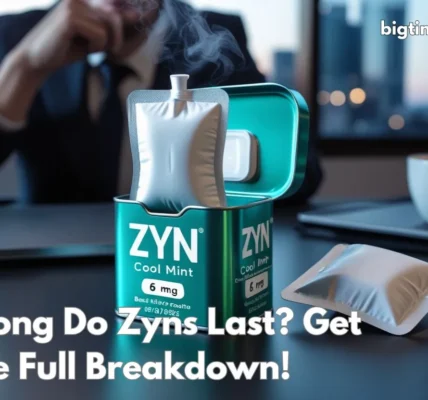Introduction
You’re at a BBQ. You are handed a cold drink in its familiar foam sleeve. What do you call it? Coozie or Koozie? Or maybe even a “cozy”?
This question about the name of your favourite can cooler befuddles a lot of people. These convenient drink coolers, though, still serve the same purpose: they chill your drink just right and keep your hands dry.
This guide is designed to clarify any confusion. We will take you through everything you need to know about these vital drink sleeves.
What Exactly is a Coozie or Koozie? Defining the Essential Drink Sleeve

The short answer is that a Coozie or Koozie is an insulated sleeve. It wraps around a can or bottle snugly. Its work is to maintain the temperature of your drink.
From keeping your cold soda cold on a hot day to keeping your hot coffee piping hot on a cold morning, these handy beverage insulators put in the work.
- Temperature Control: The primary role of a koozie is to keep your beverage at the temperature you prefer. It reduces the rate at which heat from your hand or the air travels to your drink.
- No Condensation: A second advantage is that you will never experience any condensation. You know that ring of water a cold can leave? Or how your hands feel sticky and cold? A coozie stops that. This will keep surfaces dry and ensure a firm grip.
Small enough to fit in your pocket’s back pocket, these must-have drink sleeves are lightweight and portable. That’s what makes them ideal for parties, BBQs, or even just hanging around the house.
They are also reusable and long-lasting. In reality, many people regard them as an essential component that plays a key part in their enjoyment of any cool beverage.
The Great Debate: Coozie or Koozie, Unpacking the Trademark Story
The crux of the “coozie or koozie” conundrum is a tale of brands and words. Actually, did you realize that Koozie (with a ‘K’, frequently capitalized) is a registered trademark?
Koozie Group owns this brand. It’s a lot like Kleenex with tissues or Band-Aid with bandages. These were once brand names. They later became general categories for such items.
The word Koozie most likely comes from the word cozy. It suggests comfort, whether hot or cold.
However, as the product gained popularity in the late 1970s and early 1980s, people began requesting something they could use repeatedly, and referring to any beverage insulator as a “koozie” just felt right.
That only occurred, no matter who made it. To skirt the trademark issue, other companies began using spellings like “coozie,” “cozy,” or “coolie.” This is why you will find different spellings.
It’s also why folks treat them interchangeably. Despite some battles in court over the years, the Koozie trademark remains largely intact. This is because “Koozie” is a brand.
However, the generic term is “coozie.” So, if you’re referring to the brand itself, use “Koozie.” For any generic beverage chiller, calling it a “coozie” works. This is the best answer for “Is it coozie or koozie?”.
Beyond the Name: The Science Behind Your Coozie or Koozie
It may seem like magic, but your coozie (or koozie) keeps drinks cold through simple physics. It operates by decelerating heat transfer.
When you grip a cold can or let it sit in warm air, heat flows from the warmer surroundings into the colder drink.
Aluminum cans and glass bottles are good conductors of heat. That is to say, heat travels through them easily.
- How Insulation Works: A coozie is a barrier. The majority are constructed of foam or neoprene. I5E Objects made of these materials offer very good insulation. They are full of little air bubbles. Air that is trapped is not a good conductor of heat. These air bubbles reduce the rate at which heat, on the outside of the glass, is transferred into your drink. They also put a damper on convection, preventing warm air from circulating.
In addition to preventing the temperature from falling below the dew point. Cold cans sweat with tiny drops of water. These droplets help bring heat to the drink.
The koozie slows this condensation by providing an insulating layer. This increases its insulation efficacy. And it helps keep your hands and surfaces dry. So, your koozie is not just a sleeve; it’s a clever piece of thermal engineering.
Types of Coozie or Koozie: Finding Your Perfect Fit
Drink coolers come in more forms than foam sleeves. Need something for a certain drink or occasion? There’s probably a koozie (or coozie) for it.
These are the most popular:
- Can Coozies: Fits the same as a typical soft 12oz can cooler. They are the same old foam or neoprene cylinders.
- Bottle Coozies: These are made to fit beer bottles. They tend to be zipped up or have a particular form.
- Slim Can Coozies: Ideal for thinner cans (seltzers, energy drinks). They stop wobbling.
- Wine Bottle Coozies: Larger cozies designed to fit a wine bottle. They maintain containers of wine at the correct temperature.
- Growler/Large Bottle Coozies: For your craft beer growlers or whatever big container you have.
- Collapsing Coozies: They slip easily into your pocket or purse. They are very convenient.
When discussing materials, the debate between neoprene and foam koozies is common. Foam koozies are cheaper. They are great for giveaways.
Neoprene koozies provide better insulation and will also last longer. They feel more premium. This is perfect for everyday.
Most of the new coozies are now collapsible koozies. This feature enables convenient storage and transportation. Here are the various koozie forms to know and why they matter in your koozie selection.
Custom Coozie or Koozie Personalization for Every Occasion

Personalized drink coolers are a big hit. Custom koozies are versatile. And as memorable souvenirs and awesome marketing tools.
For life’s biggest moments, wedding koozies are a popular choice for favors. My Favorite Adult Party Favors: They make a great novelty gift or brown bag gift for adults.
They are also popular on:
- Bachelor and bachelorette parties
- Family reunions
- Birthday celebrations
In addition to personal use, promotional koozies are commonly used by corporations. They slap on their logos for brand exposure.
They’re perfect for events, trade shows, or client gifts. They are widely used and more cost-effective, and that makes them a logical marketing choice.
You can make them your own in countless ways. You can create your own koozies in any color, with unique patterns, inside jokes, or pictures.
Printing processes differ, running the gamut from vivid sublimation for lifelike images to sturdy screen printing for bold logos. Koozie bulk purchases are also perfect for large events. Many sellers offer discounts for large orders.
A few even offer custom koozies with no minimum requirements for more modest needs. Give the gift that keeps on giving: a custom coozie.
Beyond Coozie or Koozie: Alternative Terms & Related Products
“Koozie or coozie” is the most popular, but these beverage insulators go by different names. These are often regional or specifically designed.
In Australia, they are often referred to as a stubby holder. This name was a reference to the popular “stubby” beer bottles in the region. Other tender phrases are:
- “Can hugger”
- “Coolie”
- “Drink, huggie.”
- “Beer jacket”
- “Can cooler”
Let me clarify the distinction with a “beer cozy”. While “cozy” is in the history of the koozie name, the word “cozy” (like a tea cozy) generally means something that’ll keep things warm.
Although a beer cozy is used for cold drinks, a koozie or coozie is primarily made for cold beverages. It isn’t, of course, and one of the most obvious ways to keep a drink at the proper temperature is to use an insulated container.
Stainless steel tumblers and vacuum mugs will provide excellent insulation and last a lifetime. They usually come with lids to prevent spills.
This design makes them perfect for extended temperature control. Opt for portable coolers (such as ice chests) when transporting multiple drinks.
These are all other pathways to similar objectives. However, the one-use cup and can koozie (or coozie) is so simple and customizable that it has remained a mainstay.
Conclusion: Embrace Your Coozie or Koozie
In the end, whether you recall it as a “Coozie or Koozie,” they are only as good as how effectively these indispensable drink holders work.
And now you understand the science that made their magic possible, which saved your drinks from ruin by keeping them perfectly cold.
You also know that there are all sorts of koozies. From special gifts to lifesavers on a hot day, these useful insulators prevail every single time. Don’t let silly spelling prevent you from sipping away at perfectly cooled drinks.
Suck it up, buttercup, and use your coozie (or koozie): It’s a brilliant bit of common-sense accessorizing that’s cheap, customizable, and downright marvelous for any sip. Tell us your favorite koozie (or coozie) story in the comments!
FAQs
What is the difference between a Coozie and a Koozie?
The only difference between the two products is that “Koozie” is a trademarked term, and “coozie” is the term assigned to any beverage can cover.
How do coozies keep drinks cold?
The reason your drink stays cooler is that coozies trap an insulating layer of air between the foam or neoprene and its surrounding medium, slowing down the process of heat transfer between your hand and the objects around you.
What are Koozies made of?
Most koozies are made from an insulating material, such as neoprene or foam, although you can also find options made from silicone, knitted fabric, or even stainless steel.
Is “koozie” a trademarked name?
Yes, “Koozie” is a registered trademark of the Koozie Group.
What are other names for a drink coozie?
Some more common terms for a drink coozie are can cooler, beverage insulator, drink sleeve, the Australian term “stubby holder,” can hugger, and coolie.








